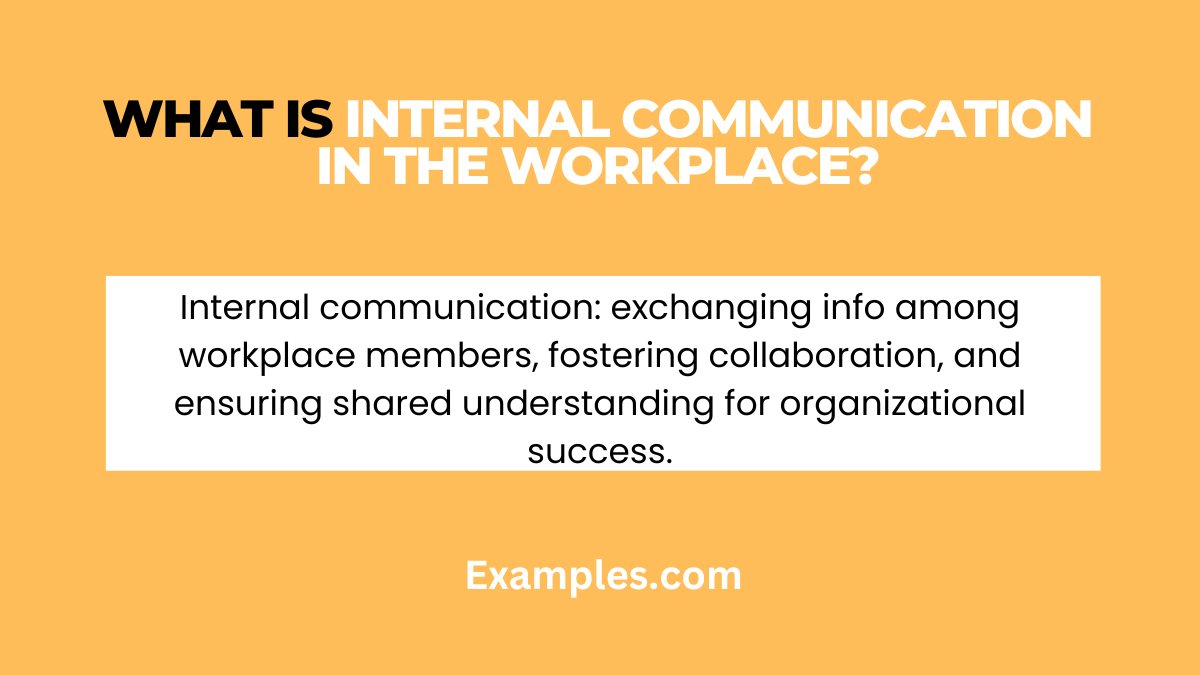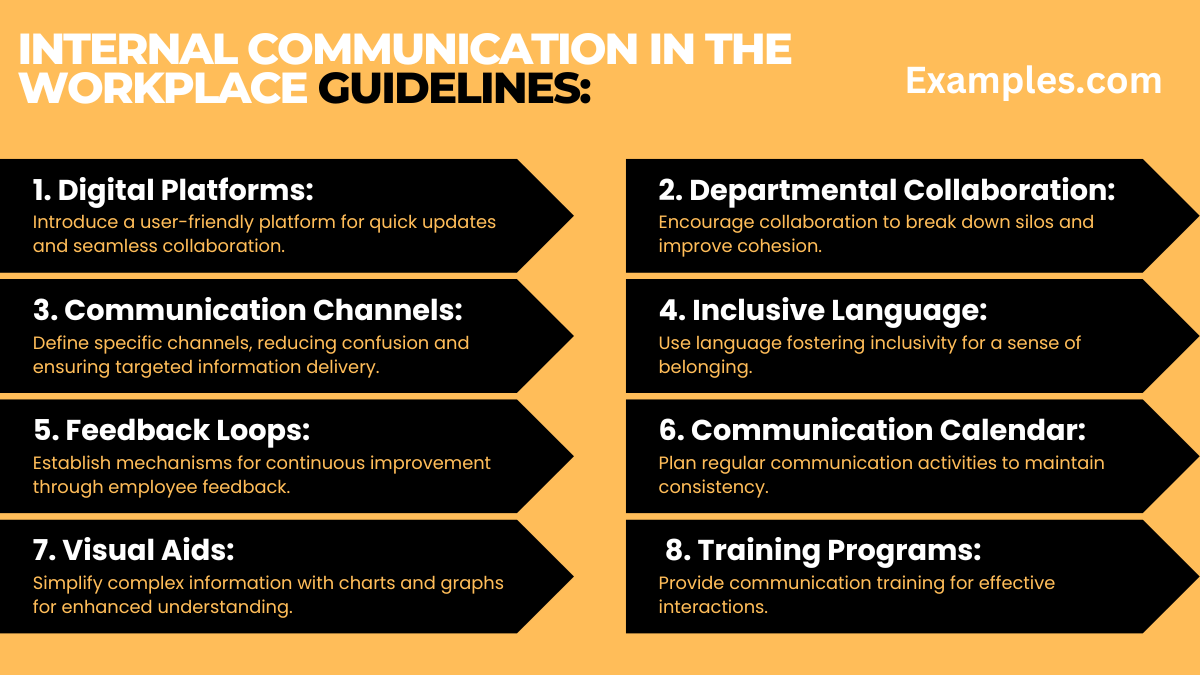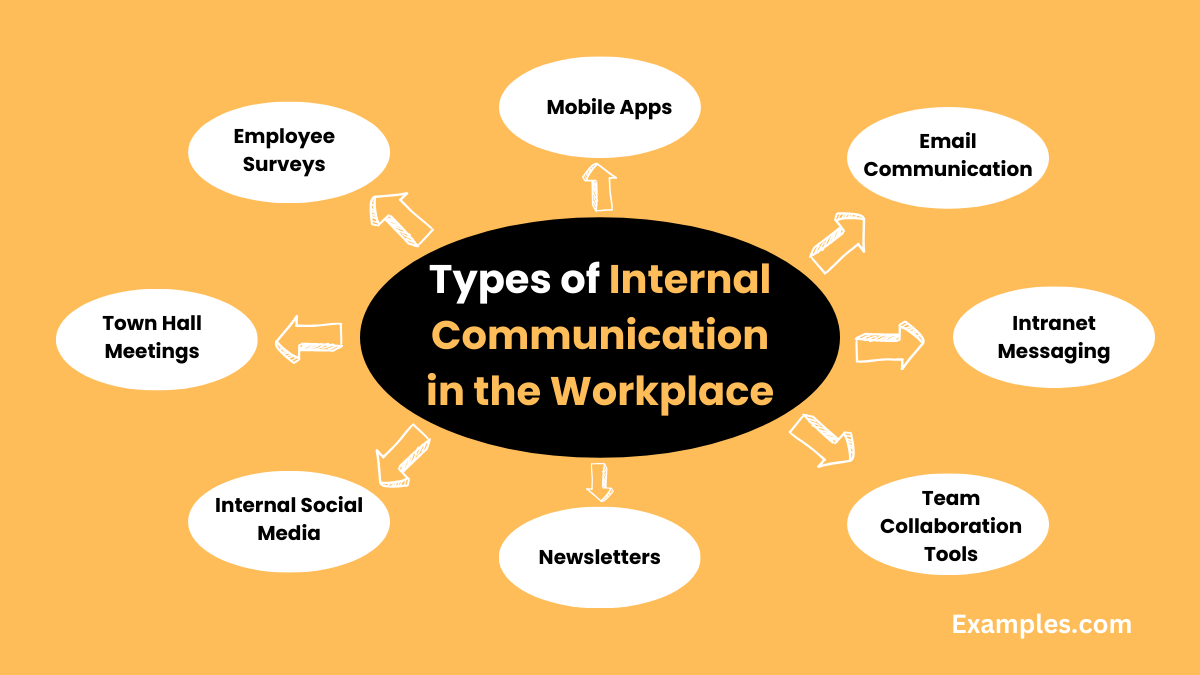7 Internal Communication in the Workplace Examples
Unlock the potential of a thriving workplace with our comprehensive guide on Internal Communication in the Workplace. Dive into insightful Communication Examples, ensuring seamless interactions and enhanced collaboration. Discover effective strategies and actionable tips to foster a communicative culture, promoting teamwork and organizational success. Elevate your workplace dynamics with this indispensable resource designed to empower your team through the art of effective communication.
What is Internal Communication in the Workplace?

Internal Communication in the workplace refers to the exchange of information among members of an organization. It involves the sharing of ideas, updates, and feedback among employees, fostering a cohesive and informed work environment. This essential process ensures that everyone is on the same page, promoting collaboration and a sense of unity. In simple terms, it’s the lifeblood of organizational synergy, connecting team members and facilitating the smooth flow of information within the workplace.
Internal Communication in the Workplace Guidelines for Improving Effectiveness:

Enhance workplace dynamics with our comprehensive guidelines for improving Internal Communication. From fostering active listening to leveraging digital tools, discover strategies that promote clarity and collaboration. Embrace a culture of open dialogue, ensuring everyone feels heard and valued. Implementing these guidelines will revolutionize your internal communication, fostering a more connected and productive workplace.
- Digital Platforms: Introduce a user-friendly digital communication platform for quick updates and seamless collaboration.
- Communication Channels: Define specific channels for different types of communication, reducing confusion and ensuring information reaches the right audience.
- Encourage Regular Team Huddles: Conduct brief, regular team huddles to discuss updates, share insights, and strengthen team bonds.
- Implement Feedback Loops: Create mechanisms for employees to provide feedback, fostering a culture of continuous improvement.
- Leverage Visual Aids: Incorporate visual aids, such as charts and graphs, to simplify complex information and enhance understanding.
- Promote Cross-Departmental Collaboration: Encourage collaboration between different departments to break down silos and improve overall organizational cohesion.
- Use Inclusive Language: Foster inclusivity by using language that resonates with diverse team members, promoting a sense of belonging.
- Establish a Communication Calendar: Plan and schedule regular communication activities to maintain consistency and avoid information gaps.
- Offer Training Programs: Provide communication training programs to enhance the skills of employees, ensuring effective interactions.
- Implement Recognition Programs: Recognize and celebrate achievements through internal communication channels, boosting morale and motivation
Benefits of Internal Communications in the workplace
Experience the transformative power of effective Internal Communication in the workplace. Elevate team synergy, boost morale, and enhance organizational efficiency through seamless information exchange. Embrace a culture of open communication to foster innovation and collaboration, driving your business toward unparalleled success.
- Enhanced Employee Engagement
- Foster commitment through transparent and consistent communication.
- Example: “Regular updates on company goals enhance engagement. Encourage input and ideas.”
- Improved Team Collaboration
- Facilitate collaboration, breaking down silos and enhancing teamwork.
- Example: “A shared digital platform fosters collaboration. Initiate cross-departmental projects for enhanced teamwork.”
- Increased Productivity
- Clear communication channels reduce misunderstandings, leading to more efficient workflows.
- Example: “Establish specific communication channels. Streamline processes for increased productivity.”
- Strengthened Organizational Culture
- Internal communications contribute to a positive work culture by reinforcing company values.
- Example: “Inclusive language strengthens culture. Use terms that resonate with diverse team members.”
- Better Employee Morale
- Regular recognition of achievements and transparent communication contribute to improved morale.
- Example: “Implement recognition programs. Celebrate accomplishments to boost morale and motivation.”
- Enhanced Innovation and Creativity
- A culture of open communication encourages employees to share ideas, leading to innovation.
- Example: “Feedback loops foster continuous improvement. Encourage employees to contribute innovative ideas.”
- Improved Employee Retention
- A positive and communicative work environment reduces turnover by fostering satisfaction and loyalty.
- Example: “Regular team huddles strengthen bonds. Communicate company values to enhance retention.”
- Effective Change Management
- Internal communications play a crucial role in navigating organizational changes.
- Example: “Communication calendars provide consistency. Communicate changes transparently for effective change management.”
- Increased Employee Satisfaction
- Clear and consistent communication leads to greater satisfaction and a positive workplace experience.
- Example: “Offer communication training programs. Invest in employee development for increased satisfaction.”
- Heightened Employee Accountability
- Well-established communication channels and expectations contribute to a culture of accountability.
- Example: “Implementing feedback loops strengthens accountability. Set expectations for individual and team performance
Types of Internal Communication in the Workplace:

Explore diverse communication channels shaping a thriving workplace, from traditional methods to modern platforms.
- Face-to-Face Communication
- Direct interaction fosters personal connections and ensures clear understanding.
- Example: “Encourage open dialogue in meetings. Share updates and encourage team members to express ideas directly.”
- Email Communication
- Use emails for detailed exchanges, documentation, and official communication.
- Example: “Use email for clear task assignments. Outline expectations and deadlines for effective communication.”
- Intranet Messaging
- A digital platform for quick updates, announcements, and informal communication.
- Example: “Leverage the intranet for quick team updates. Share relevant information and encourage quick responses for improved connectivity.”
- Team Collaboration Tools
- Platforms like Slack and Microsoft Teams facilitate real-time collaboration and information sharing.
- Example: “Utilize collaboration tools for project updates. Share files, updates, and insights in real-time for enhanced teamwork.”
- Newsletters
- Periodic newsletters provide comprehensive updates, achievements, and organizational news.
- Example: “Send out monthly newsletters for organization-wide updates. Highlight achievements and upcoming events for comprehensive communication.”
- Internal Social Media
- Platforms like Yammer or Workplace foster a social atmosphere, encouraging informal communication.
- Example: “Use internal social media for team bonding. Share team accomplishments, fun activities, and create a sense of community.”
- Town Hall Meetings
- Large-scale gatherings where leadership communicates key messages to the entire organization.
- Example: “Host town hall meetings for important announcements. Engage with employees, address concerns, and reinforce organizational goals.”
- Employee Surveys
- Collect feedback and gauge employee sentiment through periodic surveys.
- Example: “Conduct quarterly employee surveys for feedback. Use insights to make informed decisions and address concerns.”
- Mobile Apps
- Internal communication apps provide on-the-go access to updates and information.
- Example: “Implement a mobile app for instant updates. Enable employees to access critical information anytime, anywhere for enhanced connectivity.”
- Podcasts
- Audio content for conveying messages, sharing insights, and promoting a culture of listening
What is the purpose of internal communication in the Workplace?
- Information Flow
- Ensures smooth information exchange across all organizational levels.
- Bridges departmental gaps for a shared understanding of goals and updates.
- Collaborative Culture
- Cultivates a culture of active collaboration and idea-sharing.
- Breaks down silos, promoting teamwork within the organization.
- Employee Engagement
- Keeps employees engaged through regular, transparent communication.
- Acknowledges achievements and contributes to a positive work environment.
- Alignment with Organizational Goals
- Aligns individual efforts with broader organizational objectives.
- Communicates how employee contributions impact overarching goals.
- Effective Change Management
- Guides employees through organizational changes.
- Ensures transparency, reducing uncertainties during transitions.
- Boosting Employee Morale
- Recognizes and celebrates achievements regularly.
- Contributes to a positive workplace culture and uplifts employee morale.
- Encouraging Feedback and Dialogue
- Establishes a two-way communication channel.
- Encourages employees to provide feedback, share concerns, and actively participate.
- Improving Decision-Making
- Facilitates informed decision-making processes.
- Enables leaders to make choices that benefit the entire organization.
- Strengthening Leadership-Employee Relationships
- Nurtures strong relationships through open communication.
- Builds trust and transparency, essential for a healthy working dynamic.
- Fostering Continuous Improvement
- Promotes a culture of continuous improvement.
- Identifies areas for enhancement and innovation through feedback and dialogue.
In conclusion, mastering internal communication is pivotal for organizational success. This comprehensive guide delves into the intricacies of workplace communication, offering insights, examples, and actionable strategies. Embracing effective communication fosters collaboration, aligns teams with organizational goals, and creates a positive work culture. Elevate your workplace dynamics with the principles and examples shared, ensuring lasting success in the ever-evolving professional landscape.



